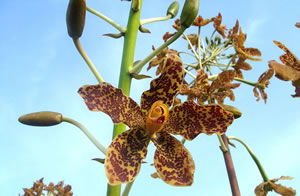Epiphytes, which include many species of orchid, are plants that live on the surface of other plants.
Although they live on other plants, epiphytes are not parasites. An epiphyte does not obtain nutrients or water from the tree it lives on. The only thing they receive from the trees on which they live is support.
 Epiphytes are subject to extremes of temperature, notably in the crown of a tree, as well as to enormous variations in the availability of water.
Epiphytes are subject to extremes of temperature, notably in the crown of a tree, as well as to enormous variations in the availability of water.
One moment, plants may be scorching in the sun, the next drenched by a tropical storm.
Tree bark does not usually hold much water. Rain flows over its surface and eventually down the tree trunk to the ground. Even after a steady downpour, the bark dries out quickly.
One tropical tree can provide a vast range of epiphytic habitats, some more hospitable than others.
The outer twigs of the canopy afford little firm base for attachment and are likely to catch the worst of the weather.
The tree's main branches, which often spread out almost horizontally from the tops of the boles of large trees within or just below the canopy, are the favorite sites for epiphytes. They offer a nice balance between sun and shade, drought and drowning, plus shelter from wind and nearly all direct solar radiation.
The vertical surfaces of the trunk itself are difficult for epiphytes to colonize. They are often in deep shade and, apart from water trickling down from the branches above, are sheltered from rainfall.
Some epiphytes have developed mechanisms for retaining water and soil-forming materials. Others just seem to endure the harsh conditions, taking up water when they can, while resisting water loss and keeping their vital processes going as best they can between times of plenty.
The simplest of these plants are the mosses and lichens, which are often common on the outermost tree branches.
Mosses and lichens absorb water quickly when rain falls.
When their environment becomes dry, they shrivel up and remain quiescent until the situation improves.
A few plants that are more complex also shrivel when they are dry and resurrect when they become wet. One of these is the epiphytic staghorn fern, Platycerium.
Orchids
Orchids are the most successful epiphytes of the tropical rainforest.
There are over 20,000 species of orchid, most of which are epiphytes.
Orchids survive as epiphytes by taking up water rapidly when it is available and by restricting its loss during drought.
Epiphytic orchids have thick white roots that spread over the surface of the bark of the trees that lend them support. The outer part of these roots is covered by a layer of dead cells called the velamen.
These cells have many small holes in their walls into which water flows with ease. Water-filled velamen cells become transparent and the greenish inner tissues become visible. When the roots are dry, the empty velamen cells scatter the light that falls on them and appear white.
By reflecting light in this way, and by forming a sort of mat over the root surface, the velamen must also help to reduce water loss from the orchids' roots.
The water absorbed by the cells of the velamen is transported into the living part of the root and from there to the leaves of the plant.
The leaves of epiphytic orchids are often thick and rigid, and contain tissue that can both absorb and store a great deal of water. The outermost cells of the leaves are usually covered with a thick waxy layer. This restricts water loss to the small pores on the leaf undersides.
The pores open and close in response to light and the water content of the plant. This provides the orchid with further protection against dehydration.